Lockheed Hudson
| Hudson A-28 / A-29 / AT-18 | |
|---|---|

| |
| Lockheed A-29 Hudson | |
| Role | transport, maritime patrol aircraft
|
| Manufacturer | Lockheed |
| Designer | Clarence "Kelly" Johnson
|
| First flight | 10 December 1938 |
| Introduction | 1939 |
| Primary users | Royal Air Force Royal Canadian Air Force Royal Australian Air Force United States Army Air Forces |
| Produced | 1938–1943 |
| Number built | 2,941 |
| Developed from | Lockheed Model 14 Super Electra |
The Lockheed Hudson is a
The Hudson served throughout the war, mainly with
Design and development

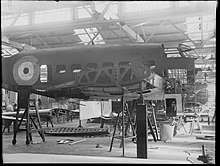
In late 1937 Lockheed sent a cutaway drawing of the Model 14 to various publications, showing the new aircraft as a civilian aircraft and converted to a light bomber.[4] This attracted the interest of various air forces and in 1938, the British Purchasing Commission sought an American maritime patrol aircraft for the United Kingdom to support the Avro Anson.
The Commission ordered 200 aircraft for use by the Royal Air Force and the first aircraft started flight trials from
A total of 350 Mk I and 20 Mk II Hudsons were supplied (the Mk II had different
The Hudson Mk V (309 produced) and Mk VI (450 produced) were powered by the 1,200 hp
Operational history
World War II
By February 1939, RAF Hudsons began to be delivered, initially equipping
Although later outclassed by larger bombers, the Hudson achieved some significant feats during the first half of the war. On 8 October 1939, over Jutland, a Hudson became the first Allied aircraft operating from the British Isles to shoot down an enemy aircraft[8] (earlier victories by a Fairey Battle on 20 September 1939 over Aachen and by Blackburn Skuas of the Fleet Air Arm on 26 September 1939 had been by aircraft based in France or on an aircraft carrier). Hudsons also provided top cover during the Battle of Dunkirk. On 23 July 1941 a Hudson shot down a Focke-Wulf Fw 200 Condor, while escorting a shipping convoy off Ireland.[9]
On 27 August 1941, a Hudson of
A Royal Australian Air Force (RAAF) Hudson was involved in the Canberra air disaster of 1940, in which three ministers of the Australian government were killed.
On 10 August, 1942 RAAF 13 squadron sank IJN auxiliary netlayer Fukuei Maru No. 15 off Beco, Portuguese Timor.[13]
In 1941, the USAAF began operating the Hudson; the Twin Wasp-powered variant was designated the A-28 (82 acquired) and the Cyclone-powered variant was designated the A-29 (418 acquired). The US Navy operated 20 A-29s, redesignated the PBO-1. A further 300 were built as aircrew trainers, designated the AT-18.
Following
Its opponents found that the Hudson had exceptional manoeuvrability for a twin-engine aircraft; it was notable for the tight turns achievable if either engine was briefly
High-scoring Japanese ace
On 23 November 1942, the crew of a
Hudsons were also operated by RAF Special Duties squadrons for clandestine operations;
Postwar use
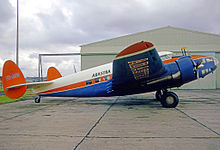
After the war, numbers of Hudsons were sold by the military for civil operation as airliners and survey aircraft. In Australia,
A total of 2,941 Hudsons were built.[20]
The type formed the basis for development of the Lockheed Ventura resulting in them being withdrawn from front line service from 1944, though many survived the war to be used as civil transports, primarily in Australia and a single example was briefly used as an airline crew trainer in New Zealand.
Variants
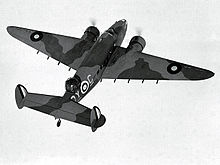

- Model 414
- Company designation for the military A-28 / A-29 and Hudson variants.
- Hudson I
- Production aircraft for the Royal Air Force (RAF); 351 built and 50 for the Royal Australian Air Force (RAAF).
- Hudson II
- As the Mk I but with spinnerlessconstant speed propellers; 20 built for the RAF and 50 for the RAAF.
- Hudson III
- Production aircraft with retractable ventral gun position; 428 built.
- Hudson IIIA
- Lend-lease variants of the A-29 and A-29A aircraft; 800 built.
- Hudson IV
- As Mk II with ventral gun removed; 30 built and RAAF Mk I and IIs were converted to this standard.
- Hudson IVA
- 52 A-28s delivered to the RAAF.
- Hudson V
- Mk III with two 1,200 hp (890 kW) Pratt & Whitney R-1830-S3C4-G Twin Waspengines; 409 built.
- Hudson VI
- A-28As under lend-lease; 450 built.
- A-28
- US Military designation powered by two 1,050 hp (780 kW) Pratt & Whitney R-1830-45 engines; 52 lend-lease to Australia as Hudson IVA.[21]
- A-28A
- US Military designation powered by two 1,200 hp (890 kW) Pratt & Whitney R-1830-67 engines, interiors convertible to troop transports; 450 lend-lease to RAF/RCAF/RNZAF as Hudson VI; 27 units passed to the Brazilian Air Force.[21]
- A-29
- US Military designation powered by two 1,200 hp (890 kW) Wright R-1820-87 engines; lend lease version intended for the RAF, 153 diverted to United States Army Air Forces (USAAF) as the RA-29 and 20 to the United States Navy (USN) as the PBO-1.[21]
- A-29A
- As A-29 but with convertible interiors as troop transports; 384 lend-lease to the RAF/RAAF/RCAF/RNZAF Chinese Air Force as Hudson IIIA, some retained by USAAF as the RA-29A.[21]
- A-29B
- 24 of the 153 A-29s retained by the USAAF converted for photo-survey.[21]

- AT-18
- Gunnery trainer version of the A-29 powered by two Wright R-1820-87 engines, 217 built.
- AT-18A
- Navigational trainer version with dorsal turret removed, 83 built.
- C-63
- Provisional designation changed to A-29A.
- PBO-1
- Twenty former RAF Hudson IIIAs repossessed for use by Patrol Squadron 82 (VP-82) of the USN
Operators

- Royal Australian Air Force
- Squadrons serving in the Pacific War:
- Article XV squadrons serving with RAF Middle East Command:
- Brazilian Air Force
- 2nd Medium Bomber Group (27 units A-28A)
- Royal Canadian Air Force
- Squadrons serving with the Home War Establishment (HWE):
- Article XV squadrons serving with RAF Coastal Command:
- Chinese Nationalist Air Force
- Portugal Air Force
- Royal Air Force
- No. 24 Squadron RAF
- No. 48 Squadron RAF
- No. 53 Squadron RAF
- No. 59 Squadron RAF
- No. 62 Squadron RAF
- No. 117 Squadron RAF
- No. 139 (Jamaica) Squadron RAF
- No. 161 Squadron RAF
- No. 163 Squadron RAF
- No. 194 Squadron RAF
- No. 200 Squadron RAF
- No. 203 Squadron RAF
- No. 206 Squadron RAF
- No. 212 Squadron RAF
- No. 217 Squadron RAF
- No. 220 Squadron RAF
- No. 224 Squadron RAF
- No. 231 Squadron RAF
- No. 233 Squadron RAF
- No. 251 Squadron RAF
- No. 267 Squadron RAF
- No. 269 Squadron RAF
- No. 271 Squadron RAF
- No. 279 Squadron RAF
- No. 285 Squadron RAF
- No. 287 Squadron RAF
- No. 288 Squadron RAF
- No. 289 Squadron RAF
- No. 353 Squadron RAF
- No. 357 Squadron RAF
- No. 500 (County of Kent) Squadron RAuxAF
- No. 517 Squadron RAF
- No. 519 Squadron RAF
- No. 520 Squadron RAF
- No. 521 Squadron RAF
- No. 608 (North Riding) Squadron RAuxAF
- Communication Flight Iraq and Persia[22]
- Royal Navy Fleet Air Arm
- 4 aircraft from Royal Air Force
- Sperry Gyroscope
- United States Army Air Forces
- United States Navy
Civil operators
- East-West Airlines
- Adastra Air Surveys[23]
- TAP – Transportes Aéreos Portugueses
- British West Indian Airways
Surviving aircraft
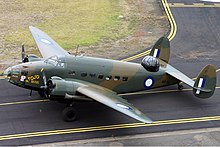
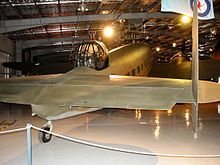
- Australia
- A16-105 – Hudson IV on static display at Canberra Airport in Pialligo, Australian Capital Territory.[25] It is owned by the Australian War Memorial and was restored at the museum's Treloar Technology Centre.[26][27][28][29]
- A16-112 – Hudson IV airworthy at the Temora Aviation Museum in Temora, New South Wales. As of March 2023 this aircraft is the only flying Hudson. It is painted as a Hudson III, serial number A16-211, with the nose art The Tojo Busters.[30][31][32][33] Ownership was transferred to the RAAF in July 2019 and it is operated by the Air Force Heritage Squadron (Temora Historic Flight).
- A16-122 – Hudson IVA in storage at the RAAF Museum in Point Cook, Victoria.[34][35]
- Canada
- BW769 – Hudson IIIA on static display at the North Atlantic Aviation Museum in Gander, Newfoundland and Labrador. It was previously mounted on a pedestal near Gander International Airport for many years. It is painted as T9422.[36]
- FK466 – Hudson VI under restoration at the National Air Force Museum of Canada in Trenton, Ontario.[37]
- New Zealand
- NZ2013 – Hudson III on static display at the Air Force Museum of New Zealand in Wigram, Canterbury.[38]
- NZ2031 – Hudson III on static display at the Museum of Transport and Technology in Western Springs, Auckland.[39][40]
- NZ2035 – Hudson III under restoration at the Ferrymead Aeronautical Society at
- NZ2049 – Hudson IIIA owned by Bill Reid[43][44] and on display at the Omaka Aviation Heritage Centre.
- NZ2084 – Hudson IIIA with Nigel Wilcox in Christchurch, Canterbury.[43][44]
- Unknown – Unknown fuselage under restoration to static display in a private collection near Ardmore Aerodrome near Manurewa, Auckland.[citation needed]
- United Kingdom
- A16-199 – Hudson IIIA on static display at the Royal Air Force Museum London in London. It is painted in the colours of the 13 Squadron of the Royal Australian Air Force.[45][46][47]
Specifications (Hudson Mk I)

Data from Lockheed Aircraft since 1913[48]
General characteristics
- Crew: Five
- Length: 44 ft 4 in (13.51 m)
- Wingspan: 65 ft 6 in (19.96 m)
- Height: 11 ft 10 in (3.61 m)
- Wing area: 551 sq ft (51.2 m2)
- Empty weight: 11,630 lb (5,275 kg)
- Gross weight: 17,500 lb (7,938 kg)
- Powerplant: 2 × Wright GR-1820-G102A Cyclone 9-cylinder radial engines, 1,100 hp (820 kW) each
Performance
- Maximum speed: 246 mph (396 km/h, 214 kn) at 6,500 ft (2,000 m)
- Cruise speed: 220 mph (350 km/h, 190 kn)
- Range: 1,960 mi (3,150 km, 1,700 nmi)
- Service ceiling: 25,000 ft (7,600 m)
- Rate of climb: 2,180 ft/min (11.1 m/s)
Armament
- Guns:
- 2 × .303 in (7.7 mm) Browning machine gunsin dorsal turret
- 2× .303 Browning machine guns in nose
- 2 ×
- Bombs: 1,400 lb (640 kg) of bombs or depth charges
See also
Related development
Aircraft of comparable role, configuration, and era
Related lists
- List of aircraft of World War II
- List of aircraft of the Royal Air Force
- List of aircraft of the Royal New Zealand Air Force and Royal New Zealand Navy
- List of military aircraft of the United States
- List of Lockheed aircraft
References
- ^ Herman 2012, pp. 11, 85, 86.
- ^ Parker 2013, pp. 59, 71.
- ^ Borth 1945, p. 244.
- ^ Bonnier Corporation (November 1937). "New Transport Plane Can Be Converted To Bomber". Popular Science Monthly. Bonnier Corporation. p. 64.
- ^ a b c d Francillon 1982, p. 146.
- ^ Parker 2013, p. 71.
- ^ Kightly 2015, p. 80.
- ^ "Collections: Lockheed Hudson IIIA." RAF Museum. Retrieved: 15 October 2014.
- ^ Nesbit, R. C. The RAF in Camera 1939-1945 1998 p.65 photograph ISBN 0750915331
- ^ Thomas, Andrew. "Icelandic Hunters - No 269 Squadron Royal Air Force." Aviation News, 24 May 2001. Retrieved: 15 October 2014.
- ^ Swanborough and Bowers 1976, p. 505.
- ^ Douglas 1986, p. 520.
- ^ "Japanese Auxiliary Netlayers". Combinedfleet.com. Retrieved 26 February 2023.
- ^ a b "Australian Story: Enemy Lines". ABC-TV, 2002. Retrieved: 30 April 2014.
- ^ Birkett, Gordon. "RAAF A16 Lockheed Hudson Mk.I/Mk.II/Mk.III/Mk.IIIA/Mk.IV/MK.IVA". ADF-Serials, 2013. Retrieved: 30 April 2014.
- ^ "RNZAF Lockheed Hudson Survivors." Cambridge Air Force, 2008. Retrieved: 15 July 2010.
- ^ "A Veteran's Advice." Archived 2010-05-22 at the Wayback Machine rsa.org.nz. Retrieved: 15 July 2010.
- ^ Marson 2001, p. 110.
- ^ Marson 2001, p. 76.
- ^ Francillon 1987, pp. 148, 501–502.
- ^ a b c d e Francillon 1982, pp. 151–152.
- ^ Lake 1999, p. 5
- ^ "LOCKHEED HUDSON". Adastra Aerial Surveys. Retrieved 13 December 2016.
- ^ "COBETA Compagnie Belge de Transports Aeriens". Airline History. Retrieved 9 November 2021.
- ^ Connery, Georgina (22 December 2016). "Restored Lockheed Hudson bomber on display at Canberra Airport". The Canberra Times. Fairfax Media. Retrieved 18 October 2017.
- ^ "Lockheed Hudson Mk IV bomber A16-105 : 1 Operational Training Unit, RAAF". Australian War Memorial. Retrieved 13 December 2016.
- ^ "Blog: Lockheed Hudson Mk IV bomber A16-105". Australian War Memorial. Retrieved 13 December 2016.
- ^ "Airframe Dossier - Lockheed Hudson IV, s/n A16-105 RAAF, c/n 414-6034, c/r VH-AGP". Aerial Visuals. AerialVisuals.ca. Retrieved 13 December 2016.
- ^ Cuskelly, Ron (25 October 2016). "VH-AGP". Adastra Aerial Surveys. Archived from the original on 20 December 2016. Retrieved 13 December 2016.
- ^ "Lockheed Hudson". Temora Aviation Museum. Archived from the original on 11 July 2012. Retrieved 13 December 2016.
- ^ "Airframe Dossier - Lockheed Hudson IV, s/n A16-112 RAAF, c/n 414-6041, c/r VH-KOY". Aerial Visuals. AerialVisuals.ca. Retrieved 13 December 2016.
- ^ "Aircraft Register [VH-KOY]". Australian Government Civil Aviation Safety Authority. Retrieved 13 December 2016.
- ^ Cuskelly, Ron (26 February 2016). "VH-AGS". Adastra Aerial Surveys. Archived from the original on 5 March 2017. Retrieved 13 December 2016.
- ^ "Airframe Dossier - Lockheed Hudson IVA, s/n A16-122 RAAF, c/n 414-6051, c/r VH-AGX". Aerial Visuals. AerialVisuals.ca. Retrieved 13 December 2016.
- ^ Cuskelly, Ron (12 September 2016). "VH-AGX". Adastra Aerial Surveys. Retrieved 13 December 2016.
- ^ "Lockheed Hudson Bomber". North Atlantic Aviation Museum. 15 September 2013. Retrieved 13 December 2016.
- ^ "Restoration". National Air Force Museum of Canada. Retrieved 2 September 2019.
- ^ "Featured Aircraft". Air Force Museum of New Zealand. Archived from the original on 20 December 2016. Retrieved 13 December 2016.
- ^ "AVIATION". Museum of Transport and Technology. MOTAT. Archived from the original on 13 November 2016. Retrieved 13 December 2016.
- ^ Wesley, Richard (23 December 2007). "Lockheed 414 Hudson GR.III". MOTAT Aircraft Collection. Blogger. Retrieved 13 December 2016.
- ^ "Lockheed Hudson NZ2035". Ferrymead Aeronautical Society. Retrieved 13 December 2016.
- ^ "Airframe Dossier - Lockheed Hudson III, s/n NZ2035 RNZAF, c/n 414-3858". Aerial Visuals. AerialVisuals.ca. Retrieved 13 December 2016.
- ^ a b Homewood, Dave. "Royal New Zealand Air Force Lockheed Hudson Survivors". Wings Over Cambridge. Retrieved 13 December 2016.
- ^ a b "RNZAF Lockheed Hudson Mk.III, Mk.IIIA, Mk.V & Mk.VI NZ2001 to NZ2094". NZDF-SERIALS. Retrieved 13 December 2016.
- ^ "Lockheed Hudson IIIA". Royal Air Force Museum. Trustees of the Royal Air Force Museum. Retrieved 13 December 2016.
- ^ Simpson, Andrew (2012). "INDIVIDUAL HISTORY" (PDF). Royal Air Force Museum. Retrieved 13 December 2016.
- ^ Cuskelly, Ron (2 March 2016). "VH-AGJ". Adastra Aerial Surveys. Retrieved 13 December 2016.
- ^ Francillon 1982, pp. 147, 158.
Bibliography
- Borth, Christy. Masters of Mass Production. Indianapolis, Indiana: Bobbs-Merrill Co., 1945.
- Cortet, Pierre (April 2002). "Des avions alliés aux couleurs japonais" [Allied Aircraft in Japanese Colors]. Avions: Toute l'Aéronautique et son histoire (in French) (109): 17–21. ISSN 1243-8650.
- Douglas, W.A.B. The Creation of a National Air Force. Toronto, Ontario, Canada: University of Toronto Press, 1986. ISBN 978-0-80202-584-5.
- Francillon, René J. (1982). Lockheed Aircraft since 1913. London: Putnam & Company. ISBN 0-370-30329-6..
- Francillon, René. Lockheed Aircraft since 1913. London: Putnam, 1987. ISBN 0-85177-805-4.
- Herman, Arthur. Freedom's Forge: How American Business Produced Victory in World War II. New York: Random House, 2012. ISBN 978-1-4000-6964-4.
- Kightly, James."Database: Lockheed Hudson". Aeroplane, Vol. 43, No. 10, October 2015. pp. 73–88.
- Lawrence, Joseph (1945). The Observer's Book Of Airplanes. London and New York: Frederick Warne & Co.
- Marson, Peter J. The Lockheed Twins. Tonbridge, Kent, UK: Air-Britain (Historians) Ltd, 2001. ISBN 0-85130-284-X.
- Parker, Dana T. Building Victory: Aircraft Manufacturing in the Los Angeles Area in World War II. Cypress, California: Amazon Digital Services, Inc., 2013. ISBN 978-0-9897906-0-4.
- Roba, Jean-Louis & Cony, Christophe (October 2001). "Donnerkeil: 12 février 1942" [Operation Donnerkeil: 12 February 1942]. Avions: Toute l'Aéronautique et son histoire (in French) (103): 25–32. ISSN 1243-8650.
- Stitt, Robert M. (July–August 2002). "Round-out". ISSN 0143-5450.
- Swanborough, Gordon and Peter M. Bowers. United States Navy Aircraft since 1911. Annapolis, Maryland: Naval Institute Press, 1976. ISBN 0-87021-792-5.
- Vincent, David. The RAAF Hudson Story: Book One Highbury, South Australia: David Vincent, 1999. ISBN 0-9596052-2-3
- Lake, Alan. Flying Units of the RAF – The ancestry, formation and disbandment of all flying units from 1912. Airlife Publishing Ltd, Shrewsbury, UK, 1999, ISBN 1840370866.
